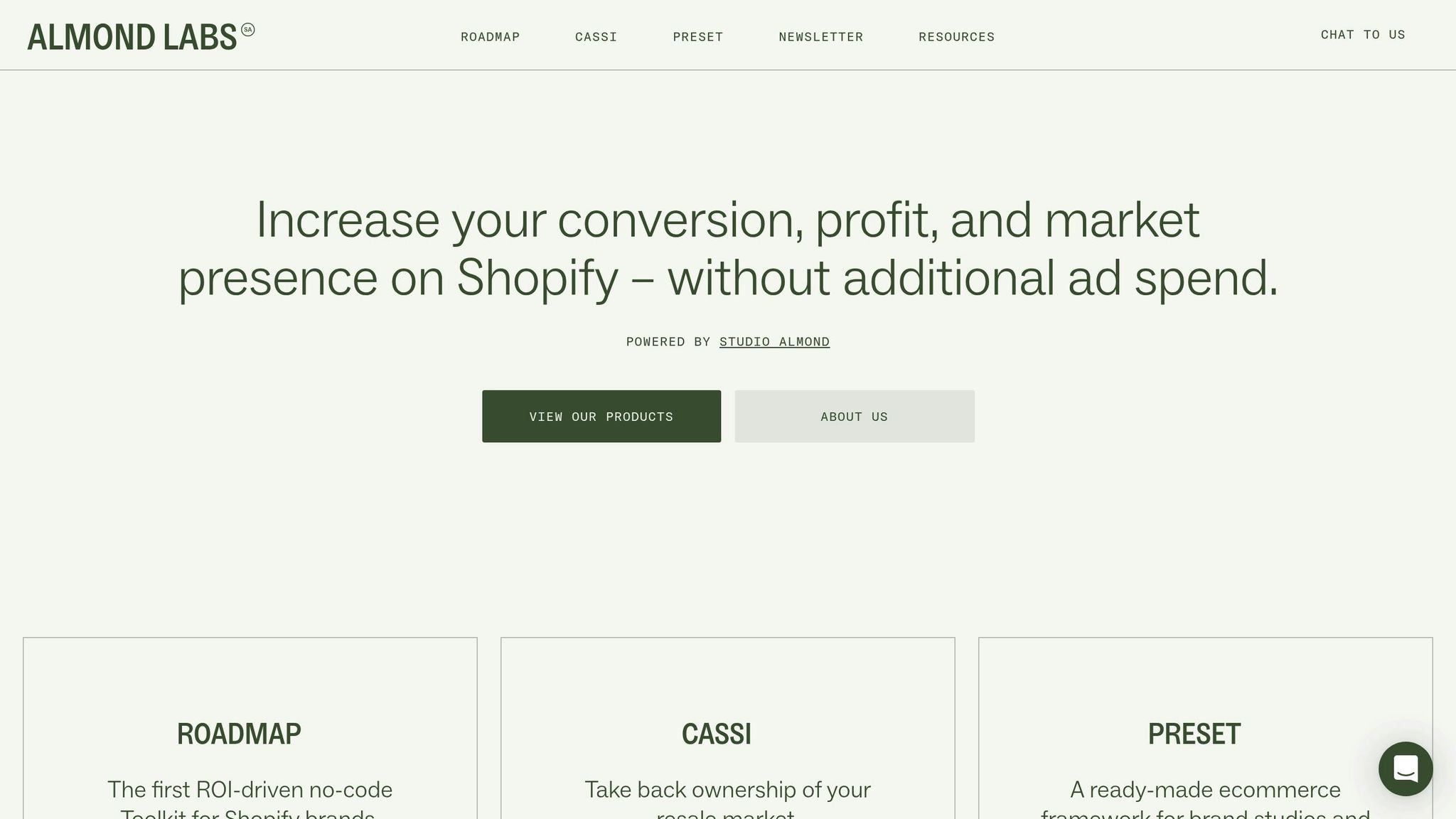
AI is changing how Kiwi businesses sell online by personalising Shopify stores for each customer. Here’s how it works and why it matters:
- Boost Sales: Personalised product recommendations can increase conversion rates by 10–30% and average order values by 15%.
- Lower Costs: AI reduces customer acquisition costs by up to 50%.
- Tailored Experiences: AI adjusts product displays based on location, weather, browsing habits, and past purchases.
- Affordable: Tools like Almond Labs’ Roadmap make this tech accessible for as little as NZ$200/month.
- Compliance Ready: Meets NZ Privacy Act 2020 requirements with secure, transparent data use.
AI uses customer data (like demographics, behaviour, and transactions) to predict preferences in real-time. For example, a shopper in Queenstown might see winter gear, while someone in Auckland sees summer outfits. With tools like Shopify’s analytics and apps like Roadmap, even small businesses can deliver these personalised experiences.
Want to get started? Install Roadmap, set up dynamic product displays, and use A/B testing to refine your approach. With AI, you can improve customer satisfaction, drive repeat business, and stay ahead in NZ’s competitive e-commerce market.
How AI Processes Customer Data for Personalisation
AI transforms customer data into actionable insights for tailored shopping experiences. From the moment a customer visits your Shopify store, algorithms start analysing various data points to create detailed customer profiles. These profiles allow AI to predict preferences and adjust product displays in real-time, ensuring a more personalised experience.
Customer Data Points That Drive Personalisation
For effective personalisation, AI relies on five key categories of customer data:
- Demographic data: Includes age, location, and gender.
- Preferential data: Tracks brand and product category preferences.
- Behavioural data: Monitors browsing habits, time on site, and cart abandonment.
- Identity data: Covers login credentials and account details.
- Engagement data: Measures interactions like email opens, click-through rates, and social media activity [5].
For Kiwi businesses, demographic data is especially useful. AI can identify if a customer is browsing from Auckland, Wellington, or Christchurch and adjust product recommendations accordingly. For instance, shoppers in Queenstown might see more winter gear during colder months, while Aucklanders may receive summer clothing suggestions earlier in the season.
Transactional data offers even deeper insights. By analysing purchase frequency, spending habits, and product pairings, AI can identify trends and recommend complementary products. For example, if customers often buy hiking boots and waterproof jackets together, the system will suggest these combinations to others.
| Data Type | Information | Impact |
|---|---|---|
| Demographic | Age, location, gender | Regional displays, age-appropriate offers |
| Behavioural | Browsing history, cart activity | Dynamic content, cart recovery strategies |
| Transactional | Purchase history, spending | Cross-selling, loyalty rewards |
| Engagement | Email clicks, social activity | Targeted campaigns, tailored communication |
These data-driven insights power dynamic product displays that cater to individual shoppers.
Connecting AI with Shopify Analytics

Shopify’s built-in analytics tools form the backbone of AI-powered personalisation. Through its Pixel manager, Shopify automatically tracks customer activity, capturing data like browsing behaviour without requiring additional setup [5]. This information feeds into AI systems, enabling real-time analysis and predictions.
AI-enhanced analytics doesn’t stop at basic metrics. It dives deeper, forecasting customer behaviour and optimising inventory management [3]. By analysing data across multiple channels, businesses gain a full picture of the customer journey - from the first click to checkout.
For Shopify Plus users, AI integration extends to email marketing platforms. These tools personalise campaigns based on a customer’s browsing and purchase history [6]. As a result, businesses can send highly targeted messages that align with individual preferences, boosting engagement rates significantly.
A critical part of this process is creating feedback loops. Post-checkout surveys, for example, provide qualitative data that helps AI refine its recommendations. Over time, these refinements make personalisation even more effective [5].
Privacy and Legal Requirements
While advanced analytics are crucial, compliance with privacy laws is non-negotiable. The New Zealand Privacy Act 2020 governs how businesses collect, use, and store personal information. This legislation applies to any organisation handling data from New Zealand residents, regardless of its location [7]. Adhering to the Act’s 13 Information Privacy Principles (IPPs) ensures proper data management.
Transparency is a cornerstone of compliance. Your Shopify store should display a clear privacy policy that outlines what information is collected, why it’s needed, and how long it will be stored [7]. This policy must be easy to find and written in plain language.
Consent is another critical aspect. Customers must understand and agree to how their data will be used for personalisation. Using a Consent Management Platform (CMP) can simplify this process and help maintain compliance [8].
Data minimisation is equally important. AI systems should collect only the information necessary to achieve personalisation goals. Gathering excessive data not only increases privacy risks but also erodes trust. Focusing on relevant data points ensures effective personalisation while safeguarding user confidence [7].
Protecting customer information throughout the AI processing cycle is essential. This includes secure data transmission, encryption, and regular security audits. If AI systems process data overseas, businesses must ensure that international standards for data protection are met [7].
Finally, appointing a privacy officer can help maintain compliance [7]. Regular reviews of your AI practices ensure they align with evolving privacy laws. Staying informed about regulatory updates and seeking legal advice when implementing new AI features can help you strike the right balance between compliance and personalisation [8].
Step-by-Step Guide to AI Product Displays on Shopify
Incorporating AI personalisation into your Shopify store is easier than you might think. With the right tools, you can set up dynamic product displays that cater to each customer's unique preferences. Follow these practical steps to get started.
Setting Up Roadmap by Almond Labs

Begin by installing Roadmap from the Shopify app store. This tool integrates AI-powered personalisation into your store effortlessly. It assigns loyalty points, uses tag-based segmentation, and applies conditional rules to create tailored product displays - all without requiring any coding skills [9].
Roadmap's tag library is a key feature. It categorises customers based on their behaviour, purchase history, and engagement levels. These tags form the basis of the conditional logic that determines what each customer sees. For instance:
- Customers tagged as "frequent buyers" might see exclusive or premium products.
- "Seasonal shoppers" could receive recommendations aligned with New Zealand's current season.
You can set campaign rules directly within Roadmap. Define which products to promote to specific segments, establish triggers for personalised displays, and let the system handle the technical side. With Roadmap up and running, your store is ready to deliver dynamic, customer-focused experiences.
Creating Dynamic Product Displays
AI's ability to analyse real-time data allows you to design displays that adapt instantly to customer activity. For example:
- Prices can automatically appear in NZD.
- Product recommendations can shift seasonally, such as promoting winter gear in Queenstown while showcasing summer essentials in Auckland.
Behavioural triggers enable personalised displays based on customer actions. First-time visitors might see your bestsellers and an introduction to your brand, while returning customers are shown recommendations tailored to their browsing history. Shoppers who have abandoned carts may encounter special offers on those specific items.
The recommendation engine uses machine learning to identify patterns, such as frequently purchased combinations or complementary products. It can also suggest alternatives when an item is out of stock. These recommendations can appear throughout the shopping journey, from the homepage to checkout.
Personalisation doesn't stop at product selection. Banners, promotional messages, and navigation elements can also be tailored. For instance:
- High-value customers might see premium collections featured prominently.
- Budget-conscious shoppers could be directed to discounts and value bundles.
Testing and Improving AI Models
To fine-tune your AI personalisation, A/B testing is essential. This involves testing one variable at a time - like product recommendations, pricing displays, or promotional banners - with clear success metrics, such as conversion rates or average order value [10].
Ensure your tests are statistically valid by calculating the required sample size. For New Zealand businesses with lower traffic, you may need to run tests for a longer period to gather meaningful data.
Segmented testing can uncover how different customer groups respond to changes. For example, Auckland shoppers may react differently to product displays compared to those in Wellington or Christchurch [10].
However, as digital marketing expert Pawel Lawrowski points out, testing might reveal trade-offs. While a test may boost conversions, it could also reduce revenue per visitor or the number of pages viewed per session [11]. Monitoring broader metrics - such as average order value, customer lifetime value, and total revenue - is crucial for understanding the full impact of your tests.
Once your displays are live, keep testing and refining. Treat optimisation as an ongoing process rather than a one-off task [12]. Roll out successful test variations gradually, monitor their long-term effects, and adjust as needed. This continuous improvement cycle helps your AI models become more accurate over time.
The results speak for themselves: stores using personalised product recommendations have reported up to a 35% increase in conversion rates and a 15% growth in average order value [4]. By rigorously testing and refining your approach, you can achieve these kinds of results while creating a more engaging shopping experience for your customers.
AI Personalisation Examples for NZ E-Commerce
AI’s ability to analyse customer behaviour is transforming how businesses in New Zealand cater to their audience. With the country’s diverse regions and unique cultural identity, local e-commerce stores are using AI to create tailored shopping experiences. By aligning with regional preferences and seasonal trends, Kiwi businesses are achieving impressive results, especially on platforms like Shopify.
Targeting Regional Customer Preferences
AI excels at uncovering regional shopping habits. For instance, shoppers in Auckland may gravitate toward urban fashion and tech gadgets, while those in Canterbury might prioritise outdoor gear and agricultural supplies. By analysing purchase data by postcode, these patterns become clear, allowing businesses to customise their offerings.
Take the example of a New Zealand fashion retailer that adopted an AI platform to integrate inventory, logistics, and customer service. This seamless data sharing boosted their order fulfilment efficiency by 25% [15].
AI also tailors online displays based on geography. For example, winter sports gear might be highlighted for customers in Queenstown, while summer apparel takes centre stage for shoppers in Northland. This goes beyond product selection - AI can also adjust shipping options, payment methods, and even marketing messages to suit regional needs.
"In a sector as competitive as retail, only the best customer experience will do. Delivering this experience requires making well-governed, democratised data available throughout the business. Our relationship with Snowflake has greatly accelerated unlocking this value and enabled us to implement AI use cases across the organisation."
- Hugh Fahy, Chief Technology Officer at David Jones [17]
AI further refines its approach by considering regional economic profiles. For instance, premium products may be promoted in higher-income areas, while value bundles are highlighted in regions with a more price-sensitive audience. Additionally, as more New Zealanders prioritise sustainability, AI can adjust displays to feature eco-friendly and ethically sourced products where demand is highest [14].
Beyond regional preferences, AI adapts to New Zealand’s seasonal and cultural calendar, offering even more opportunities for tailored experiences.
Adapting for Seasons and Local Events
New Zealand’s seasons and cultural events are ripe for AI-driven personalisation. Unlike generic seasonal adjustments, AI incorporates uniquely local elements like Matariki, rugby season, and regional festivals into its recommendations.
For example, an outdoor gear retailer used AI-powered inventory management to reduce stockouts by 30%. The system recognised that while West Coast shoppers consistently buy rain gear, Canterbury customers often seek winter mountaineering equipment [15].
DHL Express New Zealand is another standout example. By 2025, they plan to harness AI for route optimisation and inventory tracking. This approach ensures faster, more affordable shipping and helps businesses anticipate demand and manage supply chain disruptions [13]. During major events like the Rugby World Cup, AI can even promote team merchandise to customers with a history of sports-related purchases.
Cultural sensitivity is also a key consideration. AI can identify customers interested in Māori and Pacific-inspired products and present these items respectfully. For instance, it might highlight traditional designs during cultural awareness weeks or promote locally made goods that support indigenous artisans [16].
Weather-based personalisation is another game-changer in New Zealand, where climate varies significantly. By analysing MetService data alongside customer locations, AI can adjust product displays in real time. A sudden cold snap in the South Island might trigger promotions for winter clothing, while customers in the warmer northern regions continue seeing summer apparel.
Timing is everything. AI learns that New Zealanders often shop for seasonal items weeks in advance, especially during holidays like Christmas or the winter school break. By predicting these patterns, retailers can meet demand at just the right moment, contributing to the 10–30% sales boost that personalised recommendations typically deliver [15].
sbb-itb-f46a14b
Future AI Trends and Scaling Personalisation
The world of AI in e-commerce is changing fast, and it's redefining how Shopify stores engage with customers. As your business grows and traffic surges, staying ahead of these trends becomes essential to remain competitive. Beyond just customising product displays, these advancements ensure your store can handle high demand without compromising the customer experience. Tools like Almond Labs' Roadmap help Shopify merchants put these trends into action, ensuring their strategies evolve alongside their growth.
One of the most exciting shifts is agentic commerce, where AI agents autonomously manage product displays, learning from customer interactions and adjusting in real time to deliver exceptional experiences.
Conversational commerce is also on the rise, driven by AI-powered chatbots that can now manage entire shopping journeys. From answering questions to facilitating purchases, these bots are transforming how customers shop. Voice-enabled shopping is another game-changer, allowing purchases through natural language commands [19].
"Conversational commerce will continue to grow with AI-powered chatbots and virtual assistants handling everything from customer service to complete shopping experiences. Voice-enabled shopping will become more mainstream, making shopping more seamless, while traditional interfaces will become adaptive, changing in real time based on interactions." - Roy Capon, Global Head of Customer Experience at Avanade [19]
The adoption of composable architectures is also speeding up AI integration. This approach allows businesses to flexibly combine content and commerce systems, creating smoother, more tailored shopping experiences across devices. IoT-enabled gadgets are adding another layer of personalisation, while omnichannel strategies ensure customers enjoy consistent interactions everywhere they shop. According to McKinsey, omnichannel personalisation can boost revenue and retention by 10–15% [18].
Scaling personalisation effectively becomes even more critical during peak traffic events.
Managing High Traffic Periods
Big shopping moments - like Black Friday, Boxing Day sales, or even major rugby matches - are make-or-break opportunities for e-commerce stores. But handling these spikes isn’t just about keeping the site online; it’s about continuing to deliver personalised experiences when server loads are at their highest.
For example, one Shopify Plus store faced site crashes and slow performance during flash sales. After upgrading their systems, they managed to handle a 300% surge in traffic without any slowdowns [21]. Techniques like load balancing, caching, and CDNs are essential for maintaining performance during these peaks [21].
AI tools also shine during these high-stress periods. One Shopify store saw a 20% increase in recovered carts during Black Friday after implementing AI-powered call automation [20]. By reaching out to customers who had abandoned their carts, they turned potential losses into completed sales.
Real-time monitoring is non-negotiable during these events. Metrics such as cart recovery rates, conversion rates, and customer satisfaction scores help ensure AI systems are performing effectively when it matters most [20]. Platforms must also scale dynamically, adjusting resources in real time to meet demand [21].
To further optimise performance, integrating Shopify with PIM/ERP systems using tools like Laravel or Node.js ensures data stays synchronised without slowing down the site [21]. Simplifying the checkout process and enhancing mobile responsiveness can also reduce cart abandonment during critical sales periods [21].
As customer behaviour evolves, keeping AI models updated is equally essential.
Updating and Training AI Models
AI models can’t just be set up and left alone. Over time, their predictive accuracy declines as market conditions and customer behaviours shift. Regular updates are key to keeping these systems effective. Surprisingly, only about 40% of machine learning algorithms make it past the pilot stage, often because they fail to adapt to changing trends [23].
Two common challenges are data drift, where the data being analysed changes, and concept drift, where the relationships between inputs and outputs evolve [22].
"AI doesn't stop working the day you deploy it. You have to keep it learning, or it falls behind." - Selin Yazici, Data Scientist [24]
To address this, businesses should establish clear retraining strategies. One approach is performance-based retraining, which triggers updates when accuracy falls below a certain threshold. Another is periodic retraining, which happens on a regular schedule [22].
Before rolling out retrained models, A/B testing is crucial. This process compares the new model with the current one to ensure improvements are real and not just statistical noise [22]. Testing on smaller groups before a full rollout can minimise risks and provide valuable insights.
Continuous training (CT) in MLOps automates much of this process by monitoring and retraining models as new data comes in [23]. While this saves time and helps respond to changes faster, human oversight remains essential to avoid errors [24].
Version control is another critical step. Keeping detailed records of each model - along with performance metrics and training data - makes it easier to troubleshoot issues or explain decisions to stakeholders [24]. Benchmarks like MAPE (Mean Absolute Percentage Error) or F1 scores help determine when retraining is necessary, ensuring problems are caught early before they impact sales or customer satisfaction.
The natural language processing (NLP) segment of AI is projected to surpass $112 billion by 2030 [1], highlighting the importance of keeping these systems updated. Businesses that prioritise continuous improvement will be better positioned to thrive in this rapidly expanding market.
Conclusion: Building Better Shopify Stores with AI and Almond Labs
AI personalisation has shifted from being a luxury to an absolute must for New Zealand e-commerce businesses aiming to stay competitive. The stats don’t lie: 87% of retail companies report a positive impact on revenue from AI, and 94% have seen it reduce operating costs [26]. For Kiwi lifestyle brands, this technology offers a real chance to reshape how they engage with customers.
The advantages go far beyond basic product suggestions. Stores that use personalised product displays have seen conversion rates jump by as much as 35%, while average order values have climbed by 15% [4]. On top of that, personalised marketing strategies can slash customer acquisition costs by half and increase sales by 5–15% [2]. These numbers make a strong case for embracing AI-driven solutions.
Almond Labs’ Roadmap is designed to tackle these opportunities head-on for New Zealand lifestyle brands. This platform bundles powerful AI-driven tools - like personalised loyalty programmes, dynamic discounts, and smart product bundles - into a single, user-friendly system. It doesn’t stop at offering tools; it also provides quarterly strategic sessions to help brands map out revenue-boosting plans and a Knowledge Hub packed with resources to make each feature work effectively. For businesses navigating the ebb and flow of New Zealand’s seasonal shopping trends, from summer surges to winter sales, this kind of tailored support is a game-changer.
What’s more, the platform’s POS integration ensures a seamless personalised experience across both online and physical stores. Whether a customer is shopping in-store in Auckland or browsing online from Christchurch, the experience feels consistent and tailored to their preferences.
Looking to the future, the importance of AI personalisation will only grow. With 97% of retailers planning to increase their AI budgets in the next year [26] and businesses using AI strategies seeing an extra 10–12% in revenue [25], the competitive edge is undeniable.
For New Zealand lifestyle brands ready to take their Shopify stores to the next level, AI personalisation through tools like Roadmap offers a proven and measurable way forward. The technology works, the benefits are clear, and the support is there to ensure success.
FAQs
How does AI comply with the New Zealand Privacy Act 2020 when personalising product displays on Shopify?
AI adheres to the New Zealand Privacy Act 2020 by strictly following the Information Privacy Principles (IPPs). This means personal data must be collected with clear consent, used only for specific purposes, and stored securely. Transparency plays a key role - AI systems need to explain how they use data and provide customers with the ability to access or correct their information when necessary.
The Act also highlights the importance of accountability. Businesses are required to identify potential risks and take active measures to protect personal information. With these protections in place, AI-powered personalisation on Shopify can improve customer experiences while staying aligned with New Zealand's privacy laws.
How can businesses use AI tools like Roadmap to personalise product displays on their Shopify store?
To make your Shopify store feel more tailored to your customers, you can use AI tools like Roadmap to personalise product displays. Here’s how you can do it:
Start by gathering customer data - things like browsing history, purchase patterns, and preferences. This data is the foundation for AI algorithms to generate recommendations that align with what your customers are actually interested in.
Then, take advantage of AI-powered tools like Roadmap to implement these personalised displays. Roadmap offers no-code solutions, so you don’t need to be a tech expert to get started. It’s a simple way to boost customer engagement and, ultimately, sales.
Finally, make sure to focus on continuous improvement. Regularly review how customers interact with your store and tweak the AI settings as needed. This keeps the personalisation fresh and ensures your store delivers a shopping experience that keeps customers coming back.
How does AI customise Shopify product displays for New Zealand shoppers?
AI is fine-tuned to match New Zealand's distinct shopping patterns by diving into local data and trends. For instance, it can spot what’s trending in Auckland compared to Christchurch and adjust product displays to suit these preferences. It also aligns recommendations with seasonal events like summer holidays or Waitangi Day, keeping them relevant to New Zealand’s unique cultural and weather conditions.
This localised approach means retailers can showcase products that genuinely connect with Kiwi shoppers. Whether it’s summer outfits, outdoor equipment, or thoughtful gifts for special occasions, AI ensures customers find what they’re looking for - boosting both engagement and sales.
Heading 1
Heading 2
Heading 3
Heading 4
Heading 5
Heading 6
Lorem ipsum dolor sit amet, consectetur adipiscing elit, sed do eiusmod tempor incididunt ut labore et dolore magna aliqua. Ut enim ad minim veniam, quis nostrud exercitation ullamco laboris nisi ut aliquip ex ea commodo consequat. Duis aute irure dolor in reprehenderit in voluptate velit esse cillum dolore eu fugiat nulla pariatur.
Block quote
Ordered list
- Item 1
- Item 2
- Item 3
Unordered list
- Item A
- Item B
- Item C
Bold text
Emphasis
Superscript
Subscript




